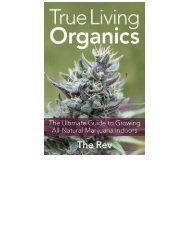You also want an ePaper? Increase the reach of your titles
YUMPU automatically turns print PDFs into web optimized ePapers that Google loves.
SOIL MIX ADDITIONS: QUICK REFERENCE<br />
It is very important that you cook (pre-process) any newly blended soil mix if there are<br />
raw elements added; don’t add an extra cup of kelp meal or something just before<br />
transplanting plants in<strong>to</strong> it, because they will not dig it. Even things like dolomite lime<br />
need <strong>to</strong> be cooked first in<strong>to</strong> the soil-mix <strong>to</strong> keep it über friendly <strong>to</strong> the microbeasties and<br />
the plants.<br />
Below is a quick reference guide for TLO soil mix additions.<br />
• Soft Rock Phosphate: Micronized (solution grade) soft rock phosphate will bring<br />
phosphorus and sulfur and will also hold the nitrogen in the soil mix and keep it from<br />
escaping in<strong>to</strong> the air as a gas (ammonia).<br />
• Bone Meal: Always use unsteamed bone meal in your TLO soil mix. Whitney Farms<br />
brand has great slow release phosphorus, calcium, some nitrogen and plenty of trace<br />
elements. Bone meal also will raise the pH due <strong>to</strong> the calcium present.<br />
• Earthworm Castings: You want living earthworm castings here if possible; Gardner<br />
& Bloome has bagged castings that are still very alive and healthy. Sterilized or dry<br />
castings are a distant second choice here. Earthworm castings do NOT need <strong>to</strong> be<br />
cooked before using.<br />
• Greensand: A great source of slow and steady minerals and a lot of potassium (K),<br />
just as the plant wants it. Greensand will take the pH up a bit due <strong>to</strong> the high potassium<br />
levels. It also adds <strong>to</strong> soil structure in a good way.<br />
• Blood Meal: Powerhouse of nitrogen (N) with a big shot of iron as well as plenty of<br />
trace minerals. This really lowers the soil mix pH and will generate actual heat if<br />
there is a lot of organic matter due <strong>to</strong> the high populations of microlife feeding and<br />
reproducing. Careful, this stuff can be as dangerous as it is wonderful!<br />
• Feather Meal: This brings long-term nitrogen and calcium as well, and endures much<br />
longer than blood meal. Always nice <strong>to</strong> have some N laying around for the plant if she<br />
wants some. Only nominally effects soil mix pH.<br />
• Alfalfa Meal: Alfalfa meal packs high nitrogen and great potassium (N and K) as well<br />
as an exotic growth hormone called triacontanol. Worms also love this, but you need <strong>to</strong><br />
be careful because the high nitrogen levels can generate actual heat like blood meal<br />
can, and this heat can kill roots. Use this in moderate amounts.<br />
• Kelp Meal: Full of exotic growth hormones and enzymes as well as massive trace and<br />
micro nutrient diversity. Also high in potassium (K) and great organic matter with a<br />
dash of nitrogen.<br />
• Perlite: Perlite aerates a soil mix and keeps aerating it, as opposed <strong>to</strong> shredded bark<br />
mulch, which processes <strong>to</strong>o quickly. Use small nugget sized perlite if possible for the<br />
greatest aeration.<br />
• Coconut Fiber (coir): Most coconut fiber is way <strong>to</strong>o fat with salts. Either fully rinse<br />
your coir or get it pre-rinsed like the Botanicare product called Cocogro, which



